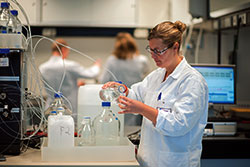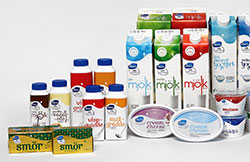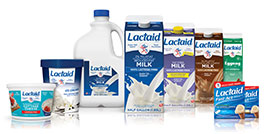Got Milk? Got Gas? No Problem
FOOD SAFETY & QUALITY
The attention-getting “Got Milk?” advertising campaign designed to increase awareness of the value of drinking milk ended earlier this year after more than 20 years, but the marketing of milk continues. However, not everyone can drink milk without experiencing discomfort, and the dairy industry is increasingly targeting people with lactose intolerance.
Humans are born with the ability to digest lactose, accomplished by the enzyme beta-galactosidase (commonly referred to as lactase) in their gastrointestinal lining, but the ability decreases after weaning and as people age. In some populations, such as Northern Europeans, lactase continues to persist as the result of a genetic mutation about 10,000 years ago when some human populations started domesticating animals. It is estimated that 70%–75% of the world’s population suffer from lactose intolerance with the prevalence ranging from less than 20% in Western countries to almost 100% in China.
People who are lactose intolerant are deficient or lacking in lactase and are therefore unable to completely digest lactose. When lactose-tolerant people consume dairy products containing lactose, lactase in the small intestine breaks down lactose into glucose and galactose, which are absorbed into the bloodstream. When lactose-intolerant people consume dairy products, however, the lactose passes undigested through the small intestine to the large intestine, where microbial flora ferment it, producing volatile fatty acids, carbon dioxide, and hydrogen. As a result, lactose-intolerant people experience abdominal pain, bloating, cramping, excess gas, and diarrhea.
Most supermarkets today offer a number of dairy products labeled “lactose-free.” According to an October 2012 report by Euromonitor, the global volume growth of lactosefree products is expected to be more than 6% per year through 2017—more than double the growth of the overall dairy industry. The increase represents recognition by food companies that many consumers are lactose-intolerant to some degree.
Martinus W. Beijerlinck, a microbiologist at the Dutch firm later known as Gist-Brocades, reported in 1889 that yeast cells could enzymatically split lactose into its components and assumed the existence of an enzyme he called lactase in yeasts, and the German biochemist and Nobelist Emil Fischer in 1894 proved that lactose hydrolysis could be catalyzed by an enzyme. The major enzymes of commercial interest are fungi such as Aspergillus species (niger and oryzae) and yeasts such as Saccharomyces species, Candida species (pseudotropicalis and kefyr), and Kluyveromyces species (marxianus, lactis, and fragilis).
--- PAGE BREAK ---
 DSM Food Specialties
DSM Food Specialties
Gist-Brocades introduced its lactase enzyme in 1964, making it the first company to make lactase commercially available for reducing the lactose content of dairy products. The Dutch company DSM (www.dsm.com) acquired Gist-Brocades in 1998 and is the primary producer of lactase worldwide. Merel Roes, Global Marketing Manager at DSM, said that DSM is the only lactase supplier with a closed supply chain, enabling it to keep full control over the quality of its product. Registered as Maxilact® in the early 1970s, the enzyme is derived from Kluyveromyces lactis by fermentation. Over the years, the company has continually worked on improving the purity of the enzyme, Roes said, and has also increased the concentration of the enzyme, making it more sustainable and cost efficient for its customers.
DSM markets several versions of lactase. Maxilact LGX and Maxilact LAGX are recommended for aseptic applications, and Maxilact A4 is suitable for whey processing. These versions are all in liquid form, but the company also markets a granulated solid for use in tablets and capsules: Tolerase™ L, which is derived from Aspergillus oryzae. It has high flowability and compressibility, and its activity at low pH makes it particularly effective to digest lactose in the stomach, Roes said.
The latest addition to the company’s portfolio of lactase products is Maxilac LGi, which is free of arylsulfatase and invertase. Arylsulfatase is an impurity present in former generations of the lactase that causes components naturally present in milk to produce off-flavor. Invertase is a common lactase impurity that hydrolyzes sucrose to invert sugar. As a result, low-lactose dairy products formulated with sucrose may contain glucose and fructose, and since glucose and fructose are sweeter than sucrose, this changes the flavor and texture profile of sugared dairy products over their shelf life. The company received a European patent for the enzyme in February 2014. Adding Maxilact LGi to a dairy formulation ensures that off-flavor is no longer an issue and that shelf life can be extended, Roes said. The enzyme is said to be the only lactase in the market that is completely free of invertase activity, thus providing the most consistent sweetness profile.
Roes said that an additional benefit of using the company’s lactase is that it adds sweetness to the end product, reducing the need for food processors to add sugar as they develop products for health and wellness. Use of the enzyme allows processors to reduce the amount of sugar in their dairy products by up to 20%, and it prevents crystallization.
As for challenges ahead, Roes said that the market for low-lactose or lactose-free products is growing very rapidly, but there is still a lot to be done to educate consumers about lactose intolerance and the solutions that are available—particularly in Asia, where the number of lactose-intolerant people is higher than in other parts of the world. The company foresees a rapid growth in overseas exports as the lactose-free dairy market continues to expand globally, she said. This requires a longer shelf life and thereby puts extra demands on enzyme quality.
--- PAGE BREAK ---
 Valio
Valio
The Finnish dairy company Valio (www.valio.com), the market leader in Europe, developed a technology to produce lactose-free milk and began marketing its Valio lactose-free milk in 2001, calling it the world’s first truly lactose-free milk (it contains less than 0.01% lactose yet tastes exactly like normal milk). The product received the Star Product of the Year award from the Finnish Food and Drinks Industries Federation in 2002.
The company’s Zero Lactose™ technology involves partially removing lactose from pasteurized cow’s milk by membrane filtration and chromatographic separation and then enzymatically hydrolyzing the remaining lactose to glucose and galactose. The minerals removed by the filtration process are then added back to the milk to reinstate its original mineral composition. Lactose-free milk powders are produced by spray drying the resulting product. The company first used its patented chromatographic separation to produce lactose as part of whey powder production. According to Maritta Timonen, Export Manager at Valio, the technology reduces the lactose content from 4.8% in regular milk to less than 0.01% without compromising the taste, and the process has been optimized over the past 10 years to be run in the most feasible way in different plants and on different production scales.
Valio’s lactose-removal technology received the European FoodTec Gold Award from the German Agricultural Society in 2006. Valio’s vice president of technology, Matti Harju, received the Nordic Dairy Technology Council’s first honorary award for his achievements in the development of new applied milk processing technologies and the Valio Zero Lactose technology in particular in 2007. And Valio’s process development team received the Finnish Engineering Award from the Finnish Association of Graduate Engineers in 2008 for the enzyme technology and the membrane separation technology.
Using enzymes from enzyme suppliers, the company launched its Valio Lactose Free™ low-fat milk drink in Finland in 2001 and followed up with launches in Sweden, Belgium, the Baltic countries, and Russia. The company began licensing its lactose-free milk production technology to dairy companies in Switzerland in 2003, providing access to the technology, analytical methods, and company expertise. Valio has also licensed its technology to dairy companies in Spain, South Korea, Norway, and the Netherlands. In addition, the company markets lactose-free milk powders to companies in the confectionery, dairy, bakery, and ready-meal food processing sectors as well as others.
The company also offers Valio IML Enzyme process, which enables continuous whey processing and lower enzyme costs. It uses an immobilized lactase that produces up to 95% hydrolysis in whey. The hydrolyzed demineralized whey syrup or whey permeate syrup is said to have a pleasant taste, good solubility, and a shelf life of up to six months. It contains less than 0.1% lactose and has low carbohydrate content and high protein content.
Valio has marketed lactose-free milk, cheese, cottage cheese, yogurt, butter, cream, sour cream, and desserts under the Valio Zero Lactose and Valio Lactose Free brands. In March 2014 the company changed the name of its products to Valio Eila® Lactose-Free. More than 50 products are marketed under that brand in Finland, Sweden, Denmark, Russia, Estonia, Latvia, and Lithuania. Valio continuously launches new lactose-free dairy products to meet needs in different markets. Timonen said that it would be important to have common regulations for the limits of residual lactose content in lactose-free and low-lactose products in all markets.
--- PAGE BREAK ---
 Lactaid Inc.
Lactaid Inc.
In the 1970s U.S. Dept. of Agriculture (USDA) researchers under the direction of Virginia Holsinger evaluated the properties of available lactase enzymes. They found that lactase from fungal sources functioned most efficiently under acid conditions, such as in the digestive tract, whereas lactase preparations from Kluyveromyces yeasts were best-suited for the treatment of milk and sweet whey, a byproduct of cheesemaking. In 1974 Alan Kligerman established SugarLo Co., which later became Lactaid Inc. (www.lactaid.com). After the first publication of the USDA studies, the company obtained an exclusive license for the Kluyveromyces marxianus var. lactis lactase enzyme, manufactured by Gist-Brocades, and worked with the USDA to develop a process using fungi-produced lactase to break down lactose. Lactaid performed studies demonstrating that the process was safe, obtained generally recognized as safe affirmation for lactase-treated milk, and initiated commercial production of lactose-reduced dairy products. USDA scientists found that the process had additional benefits besides lactose reduction: It made the milk slightly sweeter; helped reduce the aging time of various cheeses, yogurt, and buttermilk; and reduced the sandiness in ice cream caused by sugar crystallization. The Institute of Food Technologists awarded its Food Technology Industrial Acheivement Award in 1987 to Lactaid Inc. and the USDA’s Eastern Regional Research Center for their development of the enzyme.
The company introduced lactase enzyme products to the market in the 1970s and lactose-free milk in 1981. Kligerman licensed the brand to the McNeil Consumer Products Division of Johnson & Johnson in 1990 and sold the company to McNeil in 1996. Lactaid has since become the leading brand of milk sold in the United States, and the company has become the world leader in sales of lactose-reduced foods. Products marketed under the Lactaid brand are milk, ice cream, cottage cheese, and eggnog.
Juan Navia, Research Director, Consumer Health Care, at Johnson & Johnson, said that SugarLo Co. first marketed the enzyme in single-dose packets of powdered enzyme. The powder was phased out in 1981 in favor of a sterile liquid form that was much easier for consumers to use by adding drops to containers of milk, and that made possible commercial-scale production of a fluid milk already treated with lactase. The liquid and powder for consumer use were replaced by Lactaid® Tablets in 1985, enabled by improvements in tableting technology, and Lactaid 100% Lactose-Free Milk in 1981. The company in 2005 introduced an improved tablet named Lactaid FastAct, which dissolves more rapidly and is now available in both caplet and chewable forms.
HP Hood LLC (www.hood.com) produces the dairy products that are marketed under the Lactaid brand. Several other companies also produce lactose-free or lactose-reduced milk, but many are private label. HP Hood LLC uses Aspergillus oryzae for all its products. Navia said that the enzyme used today is basically the same as in the past but that ongoing improvements in fermentation technology have enabled more efficient production of the enzyme. In addition, the enzyme has been optimized over time. Since the enzyme has to be stable in each intended application, he said, the company uses basically the same enzyme but adapts it to each particular product.
 Neil H. Mermelstein, a Fellow of
Neil H. Mermelstein, a Fellow of
IFT, is Editor Emeritus of
Food Technology
[email protected]


